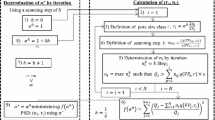Abstract
We present a pore pressure model that predicts the build-up of residual pore pressure from accumulated shear stress. The main advantage of the model is that all of the input parameters can be selected from a CSR (cyclic stress ratio)–\(N\) (number of cycles required for liquefaction) curve measured from a stress-controlled test. The formulation of the model and guidelines for selecting its parameters are presented. Comparisons with measurements validated the applicability of the model and also the parameter selection procedure. Further comparisons with another accumulated stress-based model highlight the superiority of the proposed model in terms of accuracy and ease-of-use.









Similar content being viewed by others
References
Booker JR, Rahman MS, Seed HB (1976) GADFLEA—a computer program for the analysis of pore pressure generation and dissipation during cyclic or earthquake loading. Earthquake Engineering Center, University of California at Berkeley, Berkeley, CA
Carraro JAH, Bandini P, Salgado R (2003) Liquefaction resistance of clean and nonplastic silty sands based on cone penetration resistance. J Geotech Geoenviron Eng 129:965–976
Derakhshandia M, Rathje EM, Hazirbabac K, Mirhosseinid SM (2008) The effect of plastic fines on the pore pressure generation characteristics of saturated sands. Soil Dyn Earthq Eng 28:376–386
Dobry R, Pierce WG, Dyvik R, Thomas GE, Ladd RS (1985) Pore pressure model for cyclic straining of sand. Civil Engineering Department, Rensselaer Polytechnic Institute, Troy, NY
Finn WDL, Bhatia SK (1982) Prediction of seismic pore water pressures. In: 10th International conference in soil mechanics and foundations, Stockholm, pp 201–206
Green R, Mitchell J, Polito C (2000) An energy-based excess pore pressure generation model for cohesionless soils. In: Smith JW, Carter JP (eds) John Booker Memorial Symp—Developments in Theoretical Geomechananics. Balkema, Rotterdam, pp 383–390
Ivšić T (2006) A model for presentation of seismic pore water pressures. Soil Dyn Earthq Eng 26:191–199
Koester JP (1994) The influence of fines type and content on cyclic strength. In: Prakash S, Dakoulas P (eds) Ground failures under seismic conditions, vol 44. ASCE Geotechnical Special Publications, pp 17–33
Kramer SL (1996) Geotechnical earthquake engineering. Prentice Hall, Upper Saddle River, NJ
Lee KL, Albaisa A (1974) Earthquake induced settlements in saturated sands. J Soil Mech Found Div ASCE 100:387–406
Park IJ, Shin YS, Choi JS, Kim SI (1999) A study on the conventional liquefaction analysis and application to Korean liquefaction hazard zones. In: KGS spring ’99 national conference, Seoul, Korea
Park S-S, Kim Y-S (2013) Liquefaction resistance of sands containing plastic fines with different plasticity. J Geotech Geoenviron Eng 139:825–830
Polito C, Green RA, Lee J (2008) Pore pressure generation models for sands and silty soils subjected to cyclic loading. J Geotech Geoenviron Eng 134:1490–1500
Seed HB, Lee KL (1966) Liquefaction of saturated sands during cyclic loading. J Soil Mech Found Div 92:25–58
Seed HB, Martin PP, Lysmer J (1975) The generation and dissipation of pore water pressures during soil liquefaction. Report No. UCB/EERC 75—26. Earthquake Engineering Center, University of California, Berkeley, CA
Seed HB, Idriss IM, Arango I (1983) Evaluation of liquefaction potential using field performance data. J Geotech Eng 109:458–482
Silver NL, Seed HB (1971) Volume changes in sands during cyclic loading. J Soil Mech Found Div ASCE 97:1171–1182
Silver ML, Park TK (1976) Liquefaction potential evaluated from cyclic strain-controlled properties tests on sands. Soils Found 16:51–65
Troncoso J, Verdugo R (1985) Silt content and dynamic behavior of tailing sands. In: 12th International conference on soil mechanics and foundation engineering, San Francisco, CA, p 4
Wu J, Kammerer AM, Riemer MF, Seed RB, Pestana JM (2004) Laboratory study of liquefaction triggering criteria. In: 13th World conference on earthquake engineering, Vancouver
Xenaki V, Athanasopoulos G (2003) Liquefaction resistance of sand-silt mixtures: an experimental investigation of the effect of fines. Soil Dyn Earthq Eng 23:1–12
Youd TL (1972) Compaction of sands by repeated shear straining. J Soil Mech Found Div ASCE 98:709–725
Acknowledgments
This research was supported by National Research Foundation of Korea Grant (NRF-2011-0012486). The authors gratefully acknowledge this support. The authors appreciate the assistance of Chun-Ik Park and Jae-Hoon Chang in collection and organization of the measured data.
Author information
Authors and Affiliations
Corresponding author
Rights and permissions
About this article
Cite this article
Park, T., Park, D. & Ahn, JK. Pore pressure model based on accumulated stress. Bull Earthquake Eng 13, 1913–1926 (2015). https://doi.org/10.1007/s10518-014-9702-1
Received:
Accepted:
Published:
Issue Date:
DOI: https://doi.org/10.1007/s10518-014-9702-1




